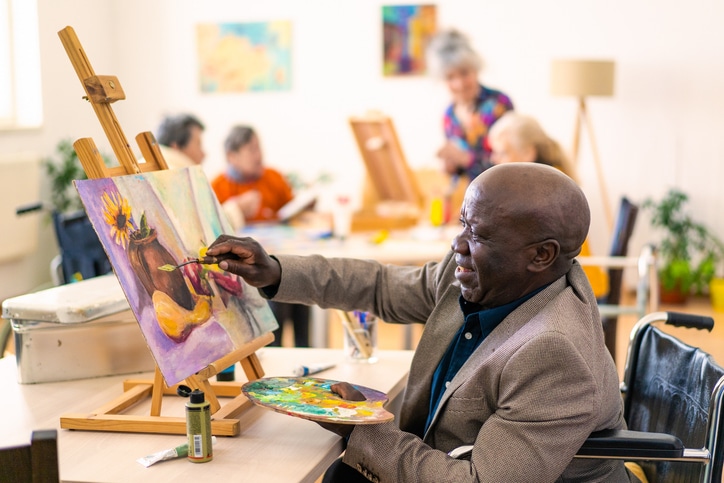In this article
Twenty-five years ago, many 55-and-over communities were the opposite of active. Think of a run-down neighborhood with a shuffleboard court and a library with old books, recalls real estate broker Jeff Lichtenstein who moved to south Florida in 2000. But today?
“Most newer 55-and-over communities we sell homes in have amenities that cater to this age group, like cooking and art classes, gyms, pools, pickleball, restaurants and social activities,” says Lichtenstein, who is now the owner of Echo Fine Properties, a luxury residential brokerage based in Palm Beach Gardens, Florida. “They are basically camps for people who are empty nesters or who want to be around folks in their own age range.”
These newer resort-style senior communities even have a new name: active senior living communities. So what exactly makes them different? From convenient amenities to social-emotional benefits, here’s what active senior living is all about, plus what to consider before choosing an active adult community, according to experts.
Key takeaways
- An active senior living community is a 55+ housing development designed to make it easier for seniors to live independent, full lives on a regular basis.
- Newer active adult communities offer a wide range of amenities, including resort-style pools, fitness centers, art and cooking classes and social activities.
- Active living communities provide a built-in social structure which can promote engagement and reduce feelings of loneliness in seniors.
- Unlike independent or assisted living facilities, active living communities often require that residents are healthy and independent with zero care needs.
What are active senior living communities?
An active senior living community is age-restricted residential housing designed to make it easier for adults 55 and older to live independent, full lives. Unlike other types of 55-and-over communities, most active adult communities are master-planned housing developments, meaning they were built strategically to include not only homes, but shared spaces, restaurants and even shops to make life more convenient.
“We’ve had to think about more than just great home design — it’s about creating intergenerational amenities that foster a sense of community, promote wellbeing and cultivate a strong sense of belonging.”
— Kris Maher, senior living expert
How does active senior living community compare to independent living?
In general, active senior living communities emphasize activities and social opportunities more than traditional independent living communities might. Independent living communities are typically planned more like traditional communities, with living spaces and amenities like housekeeping or meal services. Active senior living may include similar amenities, but is also intended to keep residents active and engaged.
How does active senior living compare to a continuing care retirement community?
Continuing care retirement communities (CCRC) are built around the idea of providing a continuum of care for seniors at different stages of aging. A typical CCRC includes independent living, assisted living and skilled nursing care, all within the same facility or community. Meanwhile, active senior living communities are focused on providing activity and engagement to seniors who are still independent and do not require higher levels of care.
What amenities do active adult communities offer?
To support active aging, master-planners behind active adult communities take a holistic approach when choosing what amenities to offer residents, explains Kris Maher, senior vice president of community development at Rancho Mission Viejo in Orange County, California, which features active living neighborhoods for adults 55 and older.
“We thoughtfully address not only the needs but desires of residents,” Maher says. “We’ve had to think about more than just great home design — it’s about creating intergenerational amenities that foster a sense of community, promote wellbeing and cultivate a strong sense of belonging.”
Here’s a closer look at common active living community amenities. Keep in mind that every community is different and offerings will vary based on which one you choose.
Accessible home designs
Home buyers who are 55 and older can expect modern home conveniences that support aging gracefully in active living communities, Maher says, perhaps including some of the following which are popular with residents within Rancho Mission Viejo’s 55+ neighborhoods:
- Living spaces on a single floor.
- Wider doorways.
- Zero-step entrances.
- Whole-home mesh Wi-Fi systems.
- Smaller yards which require less maintenance.
Exercise and fitness offerings
Gone are the days when golf was the only sport offered in retirement communities. “I’m seeing less golf which requires expensive upkeep,” Lichtenstein says. Instead, many properties are putting that money into offerings people will use more, he says, including the following:
- Tennis courts.
- Pickleball courts.
- Bocce ball courts.
- Outdoor aqua fitness pools.
- Fitness and wellness centers.
- Indoor lap pools.
- Indoor sports, including billiards, ping pong and basketball.
- Group fitness studios.
- Walking trails and greenways.
Recreational activities
Active living communities are constantly upping their game to support residents’ diverse interests. One great example is Valencia Parc at Riverland, located in Port St. Lucie, Florida, Lichtenstein says, which boasts the following enriching activities:
- Community gardening.
- Art classes.
- Pottery classes.
- Cooking classes.
- Theater performances and shows.
- Parks and nature reserves.
All-inclusive comforts and services
Perhaps one of the biggest draws of active adult communities for retirees is the inherent vacation-like atmosphere, thanks to these common luxury offerings:
- Resort-style pools.
- Shaded cabanas.
- Fire pits.
- Club houses.
- Outdoor bars, restaurants and cafes.
- Fine dining options.
- Spas and saunas.
“Active living communities provide a built-in community and social structure which can promote social engagement and reduce feelings of loneliness.”
— Michelle Feng, geropsychologist
How much does it cost to live in an active adult community?
Depending on location, layout and included amenities, home prices in active adult communities vary tremendously, according to the experts we spoke to. For example, within the single community of Valencia Parc at Riverland, homes start around $300,000 but can exceed $800,000. Whether it’s a new home or a resale, the buying process is the same as purchasing any house, Lichtenstein notes.
Living in a master-planned community also means that residents are responsible for paying Homeowners Association (HOA) fees, Maher adds. Monthly HOA fees cover both access and upkeep of all shared community amenities, landscaping, and overall maintenance and can generally fall between $300 and $1,000.
Benefits of active senior living communities
Apart from the obvious fun of living full-time on vacation, active living communities also come with both physical and mental health benefits for aging adults, according to experts.
“Active living communities provide a built-in community and social structure which can promote social engagement and reduce feelings of loneliness,” explains Michelle Feng, a licensed geropsychologist and the chief clinical officer at Executive Mental Health. Here are a few specific ways living in an active adult community can benefit seniors, according to Feng:
- Accessibility and convenience allow residents to participate and engage in activities that are healthy and meaningful to them for a longer period of time.
- Positive interactions and shared experiences can increase a sense of belonging.
- Staying socially connected, mentally stimulated and physically active can reduce depression and anxiety later in life.
Things to consider before moving into active senior living
While it may appear in a brochure that senior living communities offer just about everything, there are a few things they do not offer that seniors should consider. The first? A multi-generational and diverse population. “Not being around a mix of people can be depressing for some and feel like they are living outside of reality,” Lichtenstein says.
Additionally, active adult communities do not typically provide on-site health care like independent or assisted living facilities. “Senior living communities often require that residents are active and independent,” Feng says. “So another aspect to consider are the options that may be needed down the road in situations where more care is needed.”
Is active senior living right for you?
With the above considerations in mind, here, experts offer their top tips for determining if an active senior living community will be the right long-term fit:
- Compare multiple communities. “Senior living communities can be very different, so individuals considering a move should do their homework to see which ones align with their interests and values,” Feng says. Consider community offerings and social environments, along with the general vibe, she says.
- Plan a visit. Maher recommends touring amenities and speaking with existing neighbors to get a firsthand feel for the unique culture of a particular senior living community.
- Ask about long-term care options. From home health care rules to on-site health services offerings, Feng recommends asking about the types of higher-level care residents can access to ensure seniors will be supported in the future.
- Prioritize healthy aging services. “I would recommend paying attention to the medical and mental health resources they have accessible within the community,” Feng says. “Continuous learning is also an important aspect of healthy aging, so I would also ask what educational offerings and resources there are to continually learn and grow.”
- Consider emotional support needs. “Like any life transition, moving out of a long-time home can come with difficult emotions including grief, loss and anxiety,” Feng says. “Adjustment to a new place with new people and routines can take some time. Acknowledging these valid emotions and maintaining important relationships can help.”





